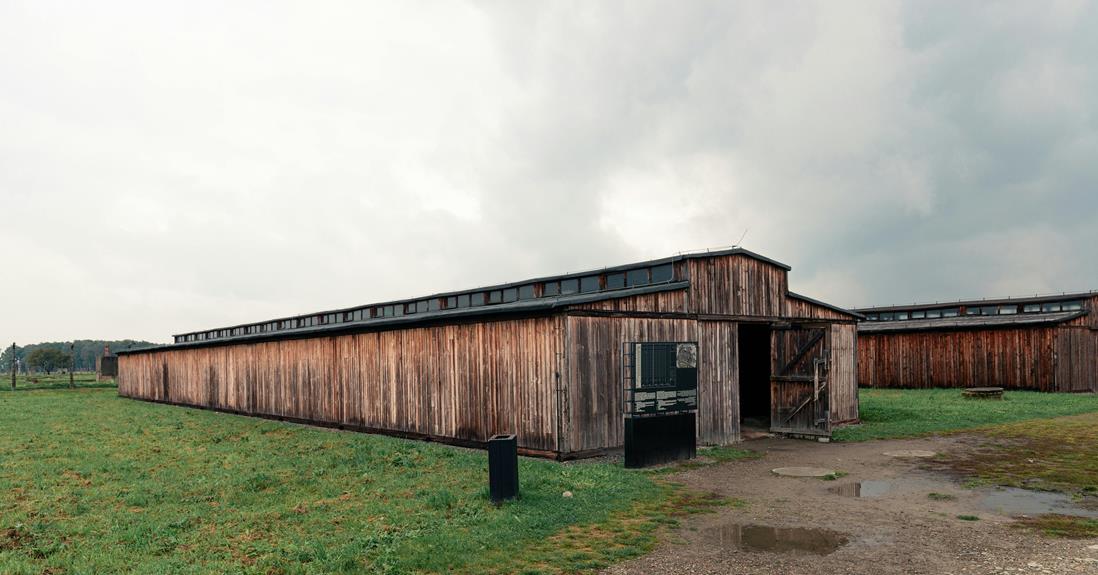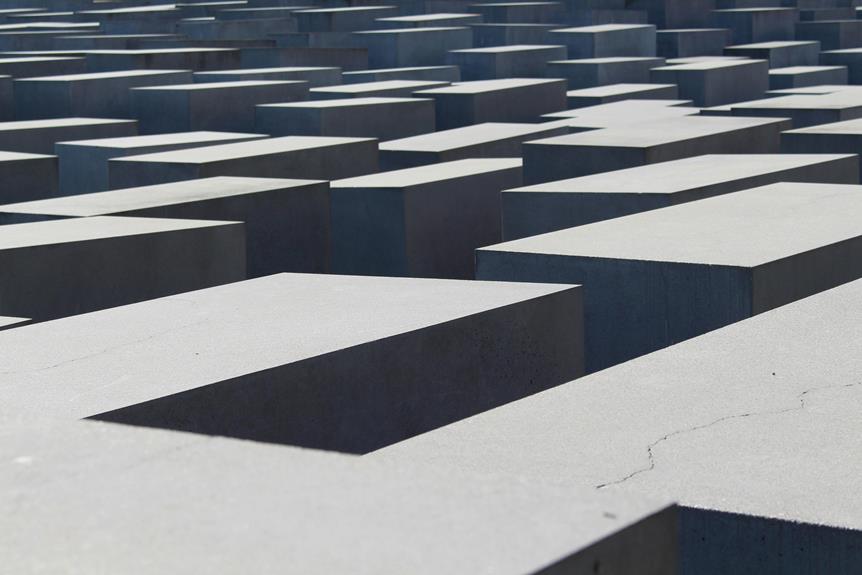Nestled in the quiet landscape of eastern Poland, Sobibor holds a somber past that echoes through the annals of history. The mere mention of this place evokes a sense of solemn reflection, serving as a poignant reminder of the atrocities committed during one of humanity's darkest chapters. As we explore the depths of Sobibor's history, it becomes apparent that behind its serene facade lies a harrowing tale of resilience, tragedy, and the enduring quest for remembrance. Join us as we unravel the layers of this significant site, where each step unearths a narrative that demands our attention and contemplation.
Key Takeaways
- Sobibor, Poland was the location of an extermination camp during WWII.
- Surrounded by forests, it was a site of isolation and mass genocide.
- Limited accommodations are available near the camp.
- Nearby towns offer lodging options for visitors to Sobibor.
- The camp played a critical role in the implementation of the 'Final Solution'.
History of Sobibor
Sobibor, located in modern-day Poland, has a history marked by its significance as an extermination camp during World War II. This site, alongside other Nazi atrocities, was part of the systematic genocide of millions of Jews and other groups deemed undesirable by the Nazi regime. Sobibor played a critical role in the implementation of the 'Final Solution,' where victims were transported to the camp under the guise of being resettled, only to face mass extermination upon arrival.
The historical significance of Sobibor lies in its dark past as one of the most efficient killing centers established by the Nazis. Between April 1942 and October 1943, an estimated 250,000 Jews were murdered in the gas chambers of Sobibor. The camp was designed for the sole purpose of industrialized mass murder, symbolizing the extreme depths of inhumanity that humanity is capable of.
Understanding the history of Sobibor is vital in commemorating the victims and educating future generations about the horrors of the Holocaust. It serves as a stark reminder of the consequences of unchecked hatred and discrimination. By acknowledging the atrocities committed at Sobibor, we honor the memory of the innocent lives lost and reaffirm our commitment to upholding freedom, tolerance, and dignity for all.
Location and Access
Situated in eastern Poland, the location of Sobibor offers visitors a solemn glimpse into one of the darkest chapters of human history. The geography surrounding Sobibor is marked by dense forests and a sense of isolation, contributing to the eerie atmosphere that shrouds the area. This remote setting adds to the somber ambiance, reminding visitors of the horrors that unfolded here during the Holocaust.
Accessing Sobibor can be done via various transportation modes. For those traveling by car, the site is located near the town of Wlodawa, approximately 30 kilometers from the Ukrainian border. Public transportation options include buses and trains that connect major cities like Lublin and Warsaw to nearby towns, from which visitors can arrange for local transportation to Sobibor.
When visiting Sobibor, accommodations in the immediate vicinity are limited due to the site's solemn nature. However, nearby towns offer lodging options ranging from hotels to guesthouses, providing visitors with a comfortable place to rest after a day of exploring the memorial. For a more immersive experience, some visitors choose to stay in accommodations that offer insights into the local culture and history, enriching their overall understanding of the region.
Camp Layout and Operations
The organization and infrastructure of Sobibor camp were meticulously designed to facilitate the systematic implementation of the Nazi regime's genocidal operations. The camp was divided into sections with specific purposes, such as the reception area, undressing rooms, gas chambers, and crematoria. This camp organization allowed for the efficient processing of victims upon their arrival, leading them through a series of steps that ended in their mass murder.
Daily routines at Sobibor were strictly regimented to guarantee the smooth operation of the camp. Prisoners were assigned various tasks, such as sorting belongings confiscated from new arrivals, maintaining the camp facilities, and assisting in the disposal of bodies. These tasks not only served practical purposes but also aimed to dehumanize the prisoners and break their spirits.
The camp layout played a pivotal role in maintaining order and security. Fences, watchtowers, and armed guards surrounded the camp to prevent escapes and deter resistance. Additionally, the barracks where prisoners were housed were overcrowded and unsanitary, contributing to the overall atmosphere of despair and hopelessness.
Prisoner Revolts and Escapes
Prisoner revolts and escapes at Sobibor were significant events that disrupted the systematic operations of the camp and posed challenges to the security measures put in place by the Nazi authorities. The prisoners at Sobibor devised various revolt strategies to resist their captors and seek freedom. One of the most notable revolts occurred on October 14, 1943, when a group of prisoners led by Alexander Pechersky, a Soviet officer, coordinated an uprising. They managed to kill several SS officers and break into the camp's armory to acquire weapons. This successful revolt led to the escape of around 300 prisoners, although many were later captured and killed.
Escape routes were pivotal for prisoners attempting to flee Sobibor. The inmates carefully planned and executed their escapes, utilizing hidden paths and gaps in the camp's perimeter. Some prisoners managed to blend in with the surrounding forests, while others sought refuge with local Polish resistance groups. The escape routes were risky and required precise timing to evade detection by the guards. Despite the dangers involved, many prisoners were willing to take the chance in pursuit of freedom from the horrors of Sobibor.
Liberation and Aftermath
Following the liberation of Sobibor, the aftermath of the camp's operations revealed the extent of the atrocities committed and the impact on survivors and the surrounding community. As news of the liberation spread, there were both feelings of relief and mourning. Liberation celebrations were mixed with the stark reality of the horrors that had taken place within the camp's walls.
Survivor testimonies played a vital role in documenting the events that occurred in Sobibor. These testimonies provided a firsthand account of the inhumane conditions, brutal treatment, and systematic genocide that characterized the camp. The survivors' narratives shed light on the resilience and courage displayed by those who endured unimaginable suffering.
The liberation of Sobibor marked the end of a dark chapter in history, but the aftermath was marked by the profound trauma experienced by survivors. Many struggled to rebuild their lives in the wake of the atrocities they had witnessed and endured. The impact of the camp's operations extended beyond its physical boundaries, affecting the surrounding community and leaving a lasting scar on the collective memory of humanity.
In the aftermath of Sobibor's liberation, efforts were made to commemorate the victims and make sure that their stories were not forgotten. The survivor testimonies served as a powerful reminder of the importance of remembrance and the ongoing fight for freedom and justice.
Memorial and Museum
Efforts to honor the memory of the victims and educate future generations about the atrocities committed at Sobibor have led to the establishment of a Memorial and Museum on the site. The architectural design of the Memorial and Museum is crafted to evoke a sense of solemnity and remembrance. The structures are designed to symbolize the suffering of the victims while also serving as a beacon of hope for a future free from such horrors. The emotional impact of visiting the Memorial and Museum is profound, as visitors are confronted with the stark reality of the atrocities that took place at Sobibor.
In addition to its architectural significance, the Memorial and Museum offer a range of educational programs aimed at fostering a deeper understanding of the Holocaust and its implications. Through guided tours, exhibitions, and interactive displays, visitors are able to engage with the history of Sobibor in a meaningful way. These educational initiatives are vital in ensuring that the memory of the victims is preserved and that the lessons of the Holocaust are never forgotten.
Furthermore, the Memorial and Museum actively engage with the local community, organizing events and initiatives that promote dialogue and reflection. By involving the community in its mission, the Memorial and Museum serves as a hub for remembrance and reconciliation, fostering a sense of collective responsibility for preserving the memory of the past.
Commemorative Events
Amidst the solemn backdrop of Sobibor, Poland, a series of commemorative events are held annually to pay tribute to the victims of the atrocities committed at the site. These events serve as a poignant reminder of the horrors that took place during the Holocaust and aim to honor the memory of those who perished in Sobibor.
One significant aspect of these commemorative events is the inclusion of survivor testimonies. These firsthand accounts provide a powerful and emotional insight into the lived experiences of those who were imprisoned in Sobibor. By sharing their stories, survivors offer a personal connection to the historical events that unfolded at the site, ensuring that the memory of the victims remains alive for future generations.
In addition to survivor testimonies, educational programs play an important role in the commemorative events held at Sobibor. These programs are designed to educate visitors about the history of the Holocaust, the specific events that occurred at Sobibor, and the importance of remembrance and understanding. Through guided tours, lectures, and interactive exhibits, participants are able to deepen their knowledge and gain a deeper appreciation for the significance of preserving the memory of the Holocaust.
Impact on Holocaust Remembrance
The commemorative events held at Sobibor, Poland, have had a significant impact on the remembrance of the Holocaust. These events serve as an essential platform for honoring the victims and educating visitors about the atrocities that occurred during World War II. Several key elements contribute to the lasting impact of these events:
- Survivor Testimonies: Hearing firsthand accounts from Holocaust survivors who experienced the horrors of Sobibor adds a personal and emotional dimension to the remembrance. These testimonies humanize the historical facts and help guarantee that the memory of the victims lives on.
- Educational Programs: Through guided tours, lectures, and exhibitions, educational programs at Sobibor provide visitors with a thorough understanding of the Holocaust. These initiatives aim to combat ignorance and intolerance by promoting knowledge and empathy.
- Artistic Representations: Art installations and performances at Sobibor offer creative interpretations of the Holocaust, engaging visitors on a different sensory level. These artistic representations provoke contemplation and reflection, fostering a deeper connection to the historical events.
- Cultural Significance: Sobibor, as a site of immense historical importance, holds cultural significance not only for Poland but for the global community. The preservation of this site and the commemorative events held there contribute to the collective memory of humanity's darkest chapter.
Frequently Asked Questions
How Did the Local Community in Sobibor Respond to the Existence of the Camp?
Local reactions to the existence of the camp varied within the community. While some individuals may have supported it due to economic opportunities or fear, others likely expressed opposition or discomfort with its presence.
Community support for the camp could have been influenced by factors such as propaganda, coercion, or ignorance of the camp's true purpose. Understanding the complex dynamics of local reactions can shed light on the broader societal attitudes towards such facilities.
Are There Any Surviving Structures or Artifacts From the Camp Still Visible Today?
Surviving structures and artifacts from historical sites provide invaluable insights into the past. The visibility of these remnants serves as a tangible connection to bygone eras, offering a glimpse into the lives of those who came before us.
Preserving such elements not only honors the legacy of those who once inhabited these spaces but also allows for a deeper understanding of the events that transpired, ensuring that history remains accessible to all who seek knowledge.
What Measures Were Taken to Prevent Prisoners From Escaping the Camp?
Security measures were paramount in preventing prisoner escapes. Guards were stationed at strategic points, fences were electrified, and watchtowers provided constant surveillance. Any attempt at escape was met with swift and severe repercussions.
Despite these measures, prisoner resistance was evident through organized rebellions and covert sabotage. The delicate balance between maintaining security and quelling dissent was a constant challenge for the camp authorities.
How Did the Surrounding Landscape of Sobibor Influence the Camp's Operations?
The surrounding landscape of an area can have a profound impact on the operations within it. In the case of Sobibor, the landscape influence played a critical role in shaping the camp's operations. The terrain, vegetation, and geographical features could have affected security measures, the movement of prisoners and guards, and the overall layout of the camp.
Understanding how the landscape influenced the camp's operations provides insights into the challenges faced and the community responses developed.
How Has the Memory of Sobibor Been Preserved in Modern Polish Culture?
The memory of the Holocaust has been preserved in modern Polish culture through various means, including Holocaust remembrance ceremonies, educational programs, and the establishment of memorial sites. These efforts aim to guarantee that the atrocities of the past are never forgotten and to honor the memory of the millions who perished during this dark chapter in history.
Through these initiatives, the legacy of the Holocaust continues to be upheld and passed down to future generations.
Conclusion
To sum up, Sobibor, Poland, stands as a somber reminder of the atrocities committed during the Holocaust. Its history as an extermination camp, the prisoner revolts, and the annual commemorative events all contribute to the ongoing impact on Holocaust remembrance.
Sobibor serves as a poignant symbol of the resilience and memory of those who suffered, ensuring that their stories are never forgotten. Its significance in the annals of history will continue to resonate with future generations.


